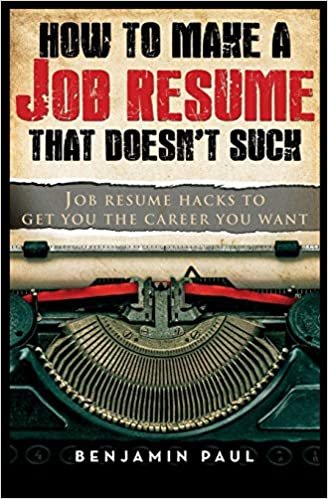संभावित नियोक्ता को यह दिखाना आवश्यक है कि आप अपने कौशल सेट और विशेषताओं के अनुसार वांछित नौकरी प्राप्त करने के लिए भूमिका में फिट हैं। एक मजबूत रिज्यूमे आपके पहले इंटरव्यू में आने की संभावना को बढ़ा सकता है। यह एक उपकरण है जो आपको अपने शीर्ष कौशल और गुणों को प्रदर्शित करने और भर्ती प्रबंधक का ध्यान आकर्षित करने की पेशकश करता है। इस लेख में, हम चर्चा करते हैं कि रिज्यूम क्या है, इसकी मूल संरचना को जानें, महत्वपूर्ण तत्वों का पता लगाएं और नियोक्ता को आपके पक्ष में निर्णय लेने के लिए उदाहरण साझा करें।
हिंदी में पूरा ब्लॉग पढ़ने के लिए यहां क्लिक करें ।
It is essential to show the prospective employer that you fit the role to obtain a desirable job according to your skill set and attributes. A strong resume can increase your chances of getting your first interview. It is a tool that offers you to display your top skills and qualities and draw a hiring manager’s attention. In this article, we discuss what is a resume, know its basic structure, explore important elements and share examples to make the employer decide in your favour.
What Is A Resume?
Determining the answer to the question, “what is a resume?” can increase your chances of writing an effective one that stands out to hiring managers. A resume is a summary of your work profile, combined with your most recent achievements and skills. A well-written resume is a one- or two-page document that states your relevant skills and work experience. Your resume puts forward your most important skills and accomplishments to inform the HR manager that you are the right candidate for the role.
Resumes also offer an effective way for you to assess your career trajectory and skills to make suitable adjustments or additions to them as per the demand in the industry. It is your first impression to the recruiter and helps them decide whether to invite you to interview. Writing a strong resume typically requires planning and understanding what the hiring managers are looking for, as it can be difficult to detail every single aspect of your work experience within one or two pages.
How To Structure Your Resume?
A resume comes with many parts and elements that are arranged and showcased in a manner that makes it easy to understand your information and highlight your most prominent attributes for the desired job. You may follow this structure to create an outstanding resume:
- Name and contact details
- Career objective
- Educational qualification
- Skills
- Professional experience
- Achievements
- Training and certifications
- Interests and hobbies
What To Do Before Writing Your Resume?
The aim of your resume is to show the employer that you are a strong candidate for the job and that you may add value to the company. To successfully do this, consider taking the following steps before writing your resume:
- Conduct research: Research about the job vacancies that interest you.
- Review job listings: Find the job-related terms in job listings, such as frequently mentioned skills and topics, to enhance your resume.
- Meet with industry professionals: Conduct informational interviews with people in your field to get a sense of the most effective qualities to receive jobs in your industry.
- Read industry materials: Go through a professional journal or a magazine related to your preferred industry.
- Review other resume samples: View strong resume samples of candidates who were successful in getting the job or at least an interview call.
To Read more such informative Blogs Click Here
hradvosrs4u Blogs
Important Elements Of A Resume
Here are some important elements that we can find in a well-structured and formatted resume:
Unique Selling Proposition (USP)
Your USP clearly indicates your most potent skills and why you are a strong fit for the role and company. It is important to reflect these skills throughout your resume. You can make them more prominent by including them in the highlights of your past and present roles within the work experience section. An example of a USP may be technical writing. Within content writing, the USP of a technical writer is the ability to write about highly technical topics, such as IT, software, gadgets and programming, to help readers understand the concepts easily.
Here are two examples of correctly using your USP on your resume:
Wrote more than 20 long-form articles per month on topics related to web development.
Drafted and updated user manuals, SOPs and informational articles while collaborating with the technical department.
Brief
Employers may scan your objective or summary first before reading your entire resume. Hence, a brief description can put forth your work history, accomplishments and skills in a concise and noticeable manner. Keep it to a maximum of four sentences. Incorporate relevant keywords and vocabulary suited to your industry and job role.
Here is an example of a strong resume objective or summary:
Hands-on experience in the management of inventory. Well known for implementing inventory management techniques.
Background
Your background is your past and present work experience. You can project this in various ways, depending on the type or format of your resume. Your employment record could include your job title, employer, location and duration of your employment, a summary of your responsibilities and achievements for each job.
Resume Types (Formats)
The following are the three most widely used resume formats:
Standard resume
A standard resume, also known as a chronological resume, lists your work experience in reverse chronological order. It starts with your most recent position. Here are the benefits of a standard resume:
- Focuses closely on your work history: This type of resume is easy to write as it focuses on a stable employment record. It clearly shows the job titles, level of responsibility and duration of your work history.
- Highlights your consistent career path: This resume format can be an effective choice, as it shows hiring managers that you were able to consistently remain employed over the past few years.
- Makes the resume easy to scan: This format makes it easy for the hiring manager to scan your resume, easily find your skills or experience and quickly determine if you are suitable for the position.
Skills-based resume
A skills-based resume demonstrates your skills and strengths that apply to the role. It focuses more on these abilities and less on your work experience or background. Here are the benefits of a skills-based resume:
- Focuses more on your skills: It diverts the focus from gaps in your career and helps employers better understand the strengths and abilities you have and how they relate to the position. It also draws more attention to your relevant skills and strengths that may get overlooked in a chronological resume.
- Makes it easier to find relevant skills: If the role requires you to have a large set of abilities, a skills-based resume lets you display these in a way that makes these strengths stand out to hiring managers.
- Acts as a more suitable option for entry-level candidates: For recent graduates or freshers, a skills-based or combination resume moves the hiring manager’s attention away from your experience and more toward the skills and abilities you gained during your education, volunteer experience or internships. This helps better portray yourself as a strong fit for entry-level roles.
Combination resume
A combination resume or hybrid resume is a blend of a standard and a skill-based resume. Here are the benefits of using a combination resume:
- Focuses on your relevant skills: While presenting a steady work history, it also brings more relevant skills to the forefront, helping the recruiter understand how you can use these skills to improve the company.
- Highlights your long-term positions: You can use it during a career change and hide short-lived jobs. It instead allows you to showcase your long-term roles and the impressive skills you gained from them.
Resume Layout Best Practices
Here are some resume layout best practices that you can follow while formatting your resume:
- Adhere to the one-page rule. Keep your information on one page of your resume unless you have relevant experience to justify it.
- Maintain sufficient white space. Avoid making the reader feel disoriented by too much text within a small space.
- Use a font that is legible. Many employers prefer Times New Roman, Verdana and Calibri font styles as these look professional and clean.
- Use a standard font size. Keep your font size 11 to 14 pt for normal text and 14 to 16 pt for section headers.
How make Resume

How to Make a Job Resume That Doesn’t Suck: Job Resume Hacks to Get You the Career You Want



Add a Comment